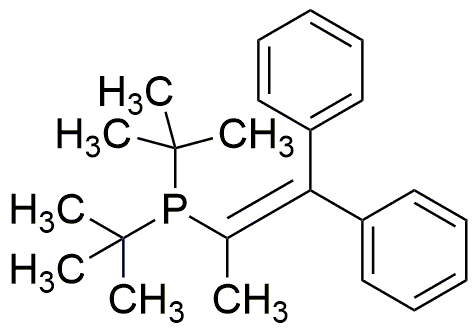|
Di-tert-butyl(1,1-diphenyl-1-propen-2-yl)phosphine is widely utilized in research focused on:
- Catalysis: This compound serves as a ligand in various catalytic processes, enhancing reaction rates and selectivity in organic synthesis, particularly in the production of fine chemicals.
- Pharmaceutical Development: It plays a role in the synthesis of complex pharmaceutical compounds, aiding in the development of new drugs with improved efficacy and reduced side effects.
- Material Science: The chemical is used in the formulation of advanced materials, such as polymers and composites, which require specific properties like thermal stability and mechanical strength.
- Organic Synthesis: It is a key reagent in organic reactions, facilitating the formation of carbon-phosphorus bonds, which are crucial in creating various organic compounds.
- Research Applications: In academic and industrial research, it is employed to explore new chemical pathways and mechanisms, contributing to the advancement of chemical knowledge and technology.
General Information
Properties
Safety and Regulations
Applications
Di-tert-butyl(1,1-diphenyl-1-propen-2-yl)phosphine is widely utilized in research focused on:
- Catalysis: This compound serves as a ligand in various catalytic processes, enhancing reaction rates and selectivity in organic synthesis, particularly in the production of fine chemicals.
- Pharmaceutical Development: It plays a role in the synthesis of complex pharmaceutical compounds, aiding in the development of new drugs with improved efficacy and reduced side effects.
- Material Science: The chemical is used in the formulation of advanced materials, such as polymers and composites, which require specific properties like thermal stability and mechanical strength.
- Organic Synthesis: It is a key reagent in organic reactions, facilitating the formation of carbon-phosphorus bonds, which are crucial in creating various organic compounds.
- Research Applications: In academic and industrial research, it is employed to explore new chemical pathways and mechanisms, contributing to the advancement of chemical knowledge and technology.
Documents
Safety Data Sheets (SDS)
The SDS provides comprehensive safety information on handling, storage, and disposal of the product.
Product Specification (PS)
The PS provides a comprehensive breakdown of the product’s properties, including chemical composition, physical state, purity, and storage requirements. It also details acceptable quality ranges and the product's intended applications.
Certificates of Analysis (COA)
Search for Certificates of Analysis (COA) by entering the products Lot Number. Lot and Batch Numbers can be found on a product’s label following the words ‘Lot’ or ‘Batch’.
*Catalog Number
*Lot Number
Certificates Of Origin (COO)
This COO confirms the country where the product was manufactured, and also details the materials and components used in it and whether it is derived from natural, synthetic, or other specific sources. This certificate may be required for customs, trade, and regulatory compliance.
*Catalog Number
*Lot Number
Safety Data Sheets (SDS)
The SDS provides comprehensive safety information on handling, storage, and disposal of the product.
DownloadProduct Specification (PS)
The PS provides a comprehensive breakdown of the product’s properties, including chemical composition, physical state, purity, and storage requirements. It also details acceptable quality ranges and the product's intended applications.
DownloadCertificates of Analysis (COA)
Search for Certificates of Analysis (COA) by entering the products Lot Number. Lot and Batch Numbers can be found on a product’s label following the words ‘Lot’ or ‘Batch’.
*Catalog Number
*Lot Number
Certificates Of Origin (COO)
This COO confirms the country where the product was manufactured, and also details the materials and components used in it and whether it is derived from natural, synthetic, or other specific sources. This certificate may be required for customs, trade, and regulatory compliance.


